|
PEPPER TREE Macropiper excelsum. Widespread on the floor of forests, Pepper Tree is a shrub which grows to 3m. Fruits are elongated, conical, fleshy and orange when ripe. They are edible with the small seeds hot to taste. Early settlers described it as an "excellent preserve, and if "gathered green it is equally good pickled". |
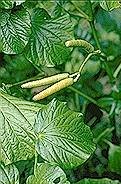 |
| NORFOLK ISLAND
ABUTILON Abutilon julianae. Last seen on the slopes of Mt Bates
in 1913 this small herb was considered extinct until rediscovered on Phillip
Island in 1985, It apparently survived on isolated cliff ledges away from
the ravages of the introduced goats, pigs and rabbits which destroyed most
of the island's vegetation. When the last of these animals were removed
the Abutilon started recolonising Phillip Island.
|
 |
| PHILLIP ISLAND HIBISCUS Hibiscus
insularis. The entire wild population of this plant is confined to
just two patches on Phillip Island, although more have been planted there
in recent times. Fortunately these have survived despite the grazing pigs,
goats and rabbits which destroyed most of the island's vegetation. With
all of these introduced animals now removed from Phillip Island, seedlings
are surviving near the original bushes. There is a marked difference between
the juvenile and adult foliage shapes, with tiny round leaves gradually
changing over ten years or more to the large leaf commonly recognised as
a hibiscus. Flowers are cream to light green coloured when they first open,
with a dark magenta centre, but turn reddish as they age.
|
 |
| DEVILS GUTS Capparis nobilis.
The woody climber Devils Guts earns its rather colourful name from the
sharp recurved thorns on the stem which can easily tear one's flesh. For
such an unpleasantly named plant, it has a most large white flower in the
Spring and Summer made conspicuous by the tuft of large white stamens which
are 2-3 cm long.
|
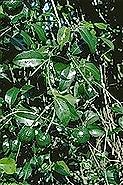 |
| BLOODWOOD Baloghia inophylla.
A blood-red sap oozes from cuts in the bark of Bloodwood. Early settlers
used the sap for staining furniture, marking convicts' clothing and thought
it a good tonic and astringent. The tree grows to about 9m and is widespread
on the island as well as being found on Lord Howe Island, eastern Australia
and New Caledonia. The trees bear either male or female flowers. Older
trees sometimes have hollows that are suitable nesting places for the endangered
Green Parrot.
|
 |
| BROAD-LEAVED MERYTA Meryta
latifolia. One of Norfolk's rare endemic species, the Meryta has the
added disadvantage of being dioecious, which means it has separate male
and female plants. When numbers become low this can be a critical factor,
if trees of both sexes are not growing close enough for the female flowers
to be pollinated by the male. This woody plant grows with a single stem
or very few branches, up to 3 or 4m and bears its leaves in a clump at
the end. It is endemic to Norfolk Island, as is its relative
Meryta
angustifolia, which has much narrower leaves. Convicts are recorded
as having used the large leaves of Meryta to wrap up dough to bake in the
ashes.
|
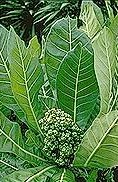 |
| NORFOLK ISLAND PALM, NIAU Rhopalostylis
baueri. The Norfolk Island Palm is prominent along gullies in or near
the National Park, but rare elsewhere on the island. It reaches 10 m in
height. Fruits are an attractive bright red when ripe. and are a favoured
food of the Green Parrot. The growing tip of the Norfolk Island Palm was
used by early settlers as a vegetable and is reported to have tasted like
a nut when raw and like an artichoke bottom, when boiled. It didn't agree
with everybody - there is a report of a convict dying from overeating this
palm "cabbage". Removal of the tip kills the palm. Ribs froth the palm
fronds were used for making brooms, and the fronds woven into baskets.
|
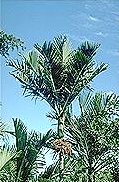 |
| NORFOLK ISLAND PINE Araucaria
heterophylla. Norfolk's majestic pine is perhaps the island's most
prominent and best known symbol. Pines as tall as 57 m with an 11 m circumference
have been recorded. One of the largest remaining trees can be seen at Hollow
Pine in the National Park. Captain Cook thought the pine would provide
"Masts for the largest Ships" but it was found later to be unsuitable for
masts. It proved a useful timber for other purposes however, and Lt. King
exported pine to Port Jackson in October 1788. Young trees have an almost
symmetrical form for the first 40 years or so. Female cones are produced
on trees older than 15 years and male cones on trees older than 40 years.
Prolific seed fall occurs every 4-5 and the seeds are a popular food source
for the Green Parrot and introduced rats.
|
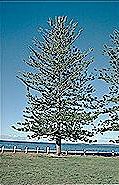 |
| SMOOTH TREE FERN Cyathea
brownii. This attractive treefern is common in the gullies of the National
Park and is occasionally seen elsewhere on the island. The trunk is usually
up to 5 m but heights of 20 m have been recorded in the past and it is
in the Guiness Book of Records as the tallest treefern species in the world.
It is distinguished from the Rough Treefern by the smoother trunk.
For the early settlers, the centre of the treefern stems provided "good
food for hogs, sheep and goats".
|
 |